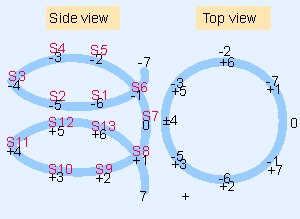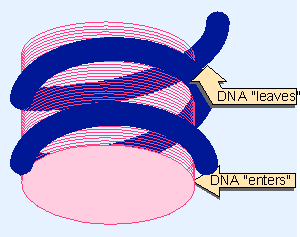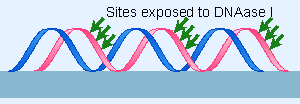4. DNA structure varies on the nucleosomal surface
19.4 DNA structure varies on the nucleosomal surface |
 |
Figure 19.11 Nicks in double-stranded DNA are revealed by fragments when the DNA is denatured to give single strands. If the DNA is labeled at (say) 5 F ends, only the 5 F fragments are visible by autoradiography. The size of the fragment identifies the distance of the nick from the labeled end. |
 |
Figure 2.4 When restriction fragments are identified by their possession of a labeled end, each fragment directly shows the distance of a cutting site from the end. Successive fragments increase in length by the distance between adjacent restriction sites. |
The exposure of DNA on the surface of the nucleosome explains why it is accessible to cleavage by certain nucleases. The reaction with nucleases that attack single strands has been especially informative. The enzymes DNAase I and DNAase II make single-strand nicks in DNA; they cleave a bond in one strand, but the other strand remains intact at this point. So no effect is visible in the double-stranded DNA. But upon denaturation, short fragments are released instead of full-length single strands. If the DNA has been labeled at its ends, the end fragments can be identified by autoradiography as summarized in Figure 19.11. (This is exactly analogous to the restriction mapping technique shown in Figure 2.4.)
 |
Figure 19.12 Sites for nicking lie at regular intervals along core DNA, as seen in a DNAase I digest of nuclei. Photograph kindly provided by Leonard Lutter. |
When DNA is free in solution, it is nicked (relatively) at random. The DNA on nucleosomes also can be nicked by the enzymes, but only at regular intervals. When the points of cutting are determined by using radioactively end-labeled DNA and then DNA is denatured and electrophoresed, a ladder of the sort displayed in Figure 19.12 is obtained.
 |
Figure 19.13 Two numbering schemes divide core particle DNA into 10 bp segments. Sites may be numbered S1 to S13 from one end; or taking S7 to identify coordinate 0 of the dyad symmetry, they may be numbered -7 to +7. |
The interval between successive steps on the ladder is 10 V11 bases. The ladder extends for the full distance of core DNA. The cleavage sites are numbered as S1 through S13 (where S1 is ~10 bases from the labeled 5′ end, S2 is ~20 bases from it, and so on). Their positions relative to the DNA superhelix are illustrated in Figure 19.13.
Not all sites are cut with equal frequency: some are cut rather effectively, others are cut scarcely at all. The enzymes DNAase I and DNAase II generate the same ladder, although with some differences in the intensities of the bands. This shows that the pattern of cutting represents a unique series of targets in DNA, determined by its organization, with only some slight preference for particular sites imposed by the individual enzyme. The same cutting pattern is obtained by cleaving with a hydroxyl radical, which argues that the pattern reflects the structure of the DNA itself, rather than any sequence preference.
The sensitivity of nucleosomal DNA to nucleases is analogous to a footprinting experiment. So we can assign the lack of reaction at particular target sites to the structure of the nucleosome, in which certain positions on DNA are rendered inaccessible.
Since there are two strands of DNA in the core particle, in an end-labeling experiment both 5′ (or both 3′) ends are labeled, one on each strand. So the cutting pattern includes fragments derived from both strands. This is implied in Figure 19.11, where each labeled fragment is derived from a different strand. The corollary is that, in an experiment, each labeled band in fact represents two fragments, generated by cutting the same distance from either of the labeled ends.
 |
Figure 19.4 The nucleosome may be a cylinder with DNA organized into two turns around the surface. |
How then should we interpret discrete preferences at particular sites? One view is that the path of DNA on the particle is symmetrical (about a horizontal axis through the nucleosome drawn in Figure 19.4). So if (for example) no 80-base fragment is generated by DNAase I, this must mean that the position at 80 bases from the 5′ end of either strand is not susceptible to the enzyme. The second numbering scheme used in Figure 19.13 reflects this view, and identifies S7 = site 0 as the center of symmetry.
 |
Figure 19.14 The most exposed positions on DNA recur with a periodicity that reflects the structure of the double helix. (For clarity, sites are shown for only one strand.) |
When DNA is immobilized on a flat surface, sites are cut with a regular separation. Figure 19.14 suggests that this reflects the recurrence of the exposed site with the helical periodicity of B-form DNA. The cutting periodicity (the spacing between cleavage points) coincides with, indeed, is a reflection of, the structural periodicity (the number of base pairs per turn of the double helix). So the distance between the sites corresponds to the number of base pairs per turn. Measurements of this type suggest that the average value for double-helical B-type DNA is 10.5 bp/turn.
 |
Figure 19.15 High resolution analysis shows that each site for DNAase I consists of several adjacent susceptible phosphodiester bonds as seen in this example of sites S4 and S5 analyzed in end-labeled core particles. Photograph kindly provided by Leonard Lutter. |
What is the nature of the target sites on the nucleosome? Figure 19.15 shows that each site has 3 V4 positions at which cutting occurs; that is, the cutting site is defined 2 bp. So a cutting site represents a short stretch of bonds on both strands, exposed to nuclease action over 3 V4 base pairs. The relative intensities indicate that some sites are preferred to others.
From this pattern, we can calculate the "average" point that is cut. At the ends of the DNA, pairs of sites from S1 to S4 or from S10 to S13 lie apart a distance of 10.0 bases each. In the center of the particle, the separation from sites S4 to S10 is 10.7 bases. (Because this analysis deals with average positions, sites need not lie an integral number of bases apart.)
The variation in cutting periodicity along the core DNA (10.0 at the ends, 10.7 in the middle) means that there is variation in the structural periodicity of core DNA. The DNA has more bp/turn than its solution value in the middle, but has fewer bp/turn at the ends. The average periodicity over the nucleosome is less than the 10.5 bp/turn of DNA in solution; it is in the range of 10.2 V10.4 bp/turn, depending on the method of measurement.
The crystal structure of the core particle suggests that DNA is organized as a flat superhelix, with 1.65 turns wound around the histone octamer. The pitch of the superhelix varies, with a discontinuity in the middle. Regions of high curvature are arranged symmetrically, and occur at positions 1 and 4. These correspond to S6 and S8, and to S3 and S11, which are the sites least sensitive to DNAase I. The high curvature is probably responsible for these changes, but their precise nature remains to be determined at the molecular level (for review see Wang, 1982).
| Reviews | |
| Wang, J. (1982). The path of DNA in the nucleosome. Cell 29, 724-726. | |